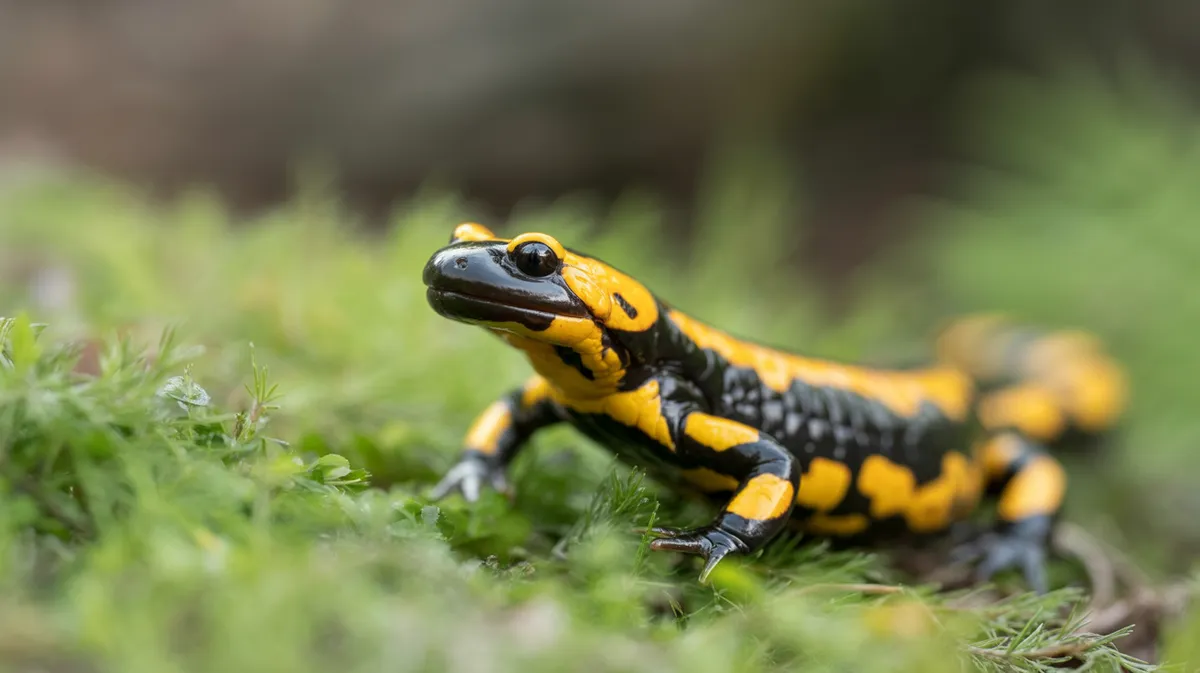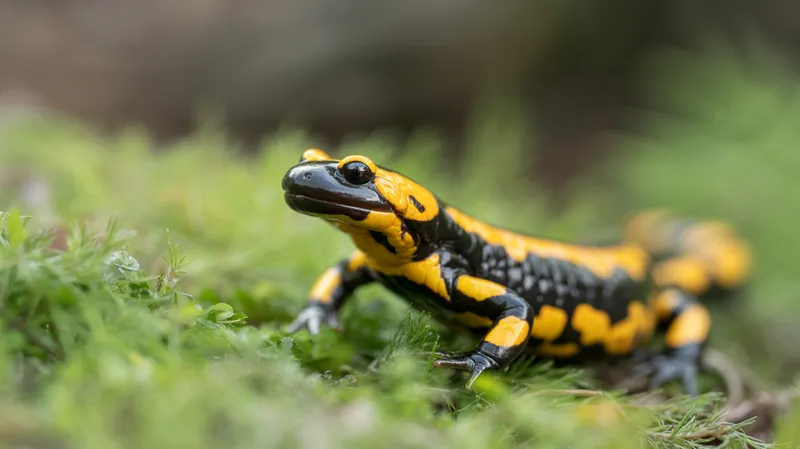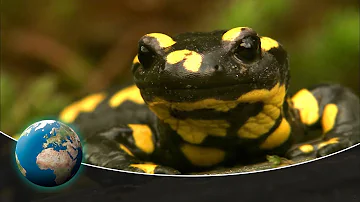
Fire Salamander
Salamandra salamandra

Meet the Fire Salamander
The fire salamander is a striking amphibian known for its black body marked with bright yellow or orange patterns, which serve as a warning to predators about its toxicity. This species is native to the forests of central and southern Europe, where it prefers moist, shaded woodlands near streams or springs. Fire salamanders are primarily nocturnal and spend much of their time hidden under logs, stones, or leaf litter. Notably, they possess skin glands that secrete potent toxins as a defense mechanism against predators.
Classification
Amphibian
Habitat
Deciduous and mixed forests near freshwater sources
Diet
Carnivore
Lifespan
10-20 years (up to 50 years in captivity)
Conservation
Least Concern
Weight
20-40 grams
📖Fascinating Facts
Toxic Defense
Fire salamanders secrete potent alkaloid toxins from their skin, which can deter or even harm predators.
Forest Dweller
They are typically found in moist, shaded forests and are rarely seen far from small streams or springs.
Live Larvae
Unlike most amphibians, female fire salamanders give birth to live larvae in water rather than laying eggs.
📋Detailed Description
The fire salamander (Salamandra salamandra) is a robust, medium-sized amphibian, typically measuring 15–25 cm in length, though some individuals can reach up to 30 cm. Its most distinctive feature is its jet-black skin adorned with vivid yellow or orange blotches and stripes, a classic example of aposematic coloration warning predators of its toxicity. The skin is smooth and moist, with prominent parotoid glands behind the eyes and along the back that secrete potent neurotoxins, primarily samandarine alkaloids. The head is broad with prominent eyes adapted for nocturnal vision, and the limbs are sturdy, suited for terrestrial locomotion. Fire salamanders are primarily terrestrial as adults, only returning to water for breeding. They are secretive and spend daylight hours concealed under logs, stones, or dense leaf litter. Their lungs are well-developed for breathing air, but they also absorb moisture and oxygen through their skin, making them highly sensitive to environmental changes. The species exhibits sexual dimorphism, with females generally larger and more robust than males. Lifespans in the wild can exceed 20 years, and individuals are known for strong site fidelity, often remaining within a small home range for their entire lives.
💡 Did you know?
Some fire salamanders can live over 50 years in captivity, making them one of the longest-lived amphibians.
🔬Research & Sources
Wikipedia Summary
The fire salamander is a common species of salamander found in Europe.
Last Modified: 6/1/2025
🎭Behavior & Social Structure
Fire salamanders are solitary and predominantly nocturnal, emerging at dusk or during rainfall to hunt. Their diet consists mainly of invertebrates such as earthworms, slugs, insects, spiders, and occasionally small vertebrates like juvenile amphibians. They employ a sit-and-wait hunting strategy, relying on their keen sense of smell and vision to detect prey. When threatened, they adopt a defensive posture, arching their bodies and exuding toxins from skin glands. Social interactions are minimal outside of the breeding season, and individuals are territorial, using chemical cues to mark and recognize their home ranges. During the day, they remain hidden to avoid desiccation and predation, becoming more active in humid or rainy conditions.
👶Reproduction & Life Cycle
Fire salamanders exhibit internal fertilization, with males depositing a spermatophore that the female picks up with her cloaca. Breeding typically occurs in early spring or autumn, depending on local climate. Females are ovoviviparous, retaining fertilized eggs internally until they hatch. After a gestation period of 6–9 months, females deposit fully formed aquatic larvae into clean, well-oxygenated streams or springs. Larvae are carnivorous and undergo metamorphosis over 2–6 months, depending on temperature and food availability, before transitioning to a terrestrial lifestyle. Females may give birth to 10–70 larvae per breeding event, and there is no parental care post-larval deposition.
🛡️Adaptations & Survival
Fire salamanders possess several key adaptations for survival. Their aposematic coloration and potent skin toxins deter most predators, including birds and mammals. The toxins, particularly samandarine, can cause muscle convulsions and hypertension in vertebrates. Their permeable skin allows for cutaneous respiration and moisture absorption, critical for survival in humid forest environments. Behavioral adaptations include nocturnality and secretive habits to minimize water loss and predation risk. Larvae possess external gills for aquatic respiration, which are resorbed during metamorphosis. Adults are highly philopatric, returning to the same breeding sites annually, which may enhance reproductive success in stable habitats.
📚Research Sources
🎨Cultural Significance
The fire salamander has a rich history in European folklore and mythology. Its striking appearance and association with fire (due to its tendency to emerge from logs thrown on fires) led to beliefs that it could withstand flames or even extinguish them. In alchemy and medieval symbolism, the salamander represented transformation, endurance, and the element of fire. It has appeared in literature, heraldry, and as a symbol of resilience and protection. There are no significant traditional uses in medicine or cuisine, likely due to its toxicity.
🔬Recent Research & Discoveries
Recent research has focused on the impact of Bsal chytridiomycosis on fire salamander populations, with studies investigating disease transmission, resistance, and mitigation strategies. Genetic studies have revealed significant regional variation and the existence of several subspecies, reflecting historical isolation and adaptation to local environments. Conservation efforts are increasingly emphasizing habitat connectivity, disease monitoring, and captive breeding programs. Ongoing ecological studies are examining the species' role in forest food webs and its sensitivity to environmental changes, making it a valuable bioindicator for ecosystem health.
🎥Wildlife Videos

Fire Salamander - The Last Urban Dragon | Free Documentary Nature
Fire Salamander - The Last Urban Dragon | Free Documentary Nature Watch 'Fire Salamander - Spectacular Footage of the ...
Free Documentary - Nature

Nocturnal wanderer: The fire salamander
Almost everyone knows of him, but very rarely does anyone actually get to see this nocturnal wanderer. This is because he leads ...
Free High-Quality Documentaries

Night of the Salamander - The Secrets of Nature
The film reveals all the miracles and curiosities in the salamander world that, until now, were only known to a few experts in the ...
Go Wild

The most fascinating salamander in the world! Europe's FIRE SALAMANDER!
This is an "on-the-road" episode of Nature at Your Door. While hiking in Switzerland walking across the trail in front of me, in broad ...
Nature at Your Door Frank Taylor

Into the Forest: Amphibian Nature Documentary
The Fire Salamander and its plight with Bsal are featured. Bsal is a microscopic fungus that was accidentally imported into Europe ...
Bryan Maltais
![Fire Salamander - Nature Documentary [HD]](https://i.ytimg.com/vi/QPsOx2gZ5sg/hq720.jpg?sqp=-oaymwE2COgCEMoBSFXyq4qpAygIARUAAIhCGAFwAcABBvABAfgB_gmAAtAFigIMCAAQARhyIF0oIDAP&rs=AOn4CLCOlt5uFCnHCbbZfcwYoR18V4UY5w)
Fire Salamander - Nature Documentary [HD]
One look at this I hid the fire salamander jackpot in that wood pile now this lets me show you the great variation in their markings ...
Don Donk
🌍Habitat Information
The Fire Salamander typically inhabits Deciduous and mixed forests near freshwater sources environments. Fire Salamanders have adapted to their environments with specialized features and behaviors.
Primary Habitat:
Deciduous and mixed forests near freshwater sources
More detailed habitat information will be available soon.
🛡️Conservation Status
The Fire Salamander is currently classified as Least Concern. Conservation efforts are crucial for preserving this species for future generations.
Common Threats:
- 🏠Habitat loss and fragmentation
- 🌡️Climate change impacts
- 🎯Hunting and poaching
- 🏭Human-wildlife conflict
⚠️Threats & Conservation Challenges
Despite being historically widespread and locally abundant, fire salamander populations are increasingly threatened by habitat loss, fragmentation, pollution (especially from pesticides and acid rain), road mortality, and climate change. A major recent threat is the emergence of the chytrid fungus Batrachochytrium salamandrivorans (Bsal), which has caused catastrophic declines in some populations, particularly in the Netherlands, Belgium, and Germany. Illegal collection for the pet trade and introduction of invasive species also pose risks. The IUCN currently lists the species as 'Vulnerable' due to these ongoing declines, with some regional populations at risk of extirpation.
🔬Scientific Classification
Scientific Name
Salamandra salamandra
Classification Hierarchy
🔍 About Taxonomic Classification
Taxonomic classification is a hierarchical system used by scientists to classify and organize living organisms based on shared characteristics and evolutionary relationships.
The system moves from broad categories (Kingdom) to increasingly specific ones, with each animal's scientific name typically consisting of its Genus and species.
📝Community Notes
Share your observations and insights about the Fire Salamander with our community of wildlife enthusiasts.
Join Our Community
Sign in to share your observations and connect with fellow wildlife enthusiasts.
Sign In to ContributeNo community notes yet
Be the first to share your observations about the Fire Salamander!
Explore Fire Salamander
Select a tab above to learn more about this amazing animal.
📸Photo Gallery
No photos available for this animal yet.
🌟Discover More Wildlife
Continue your journey of discovery with more fascinating animals from our database
